Proposal Innovative Probiosomial Tecnology for Strengthening Of the Immune System
Bruno Riccardi 1*, Tomas De Paoli 2, Sergio Resta 3
|
|
|
Abstract
The frequent spread of infectious diseases, viral or bacterial that continually affects our world, poses the need to adopt increasingly powerful methods to overcome the ability of pathogens to adapt, evolve and reduce the effectiveness of traditional therapies. The recent pandemic from Covid19 has highlighted in all its drama because traditional methods of treatment cannot overcome the pathogenic load of this virus and even less will succeed in winning the next pandemics. This manuscript proposes a holistic approach in the fight against infections, which in addition to dealing with the pathologies in place with the traditional strategies of care and prevention, is aimed primarily at strengthening the immune system of people, using advanced technologies to achieve maximum effectiveness.
Keywords: Infectious diseases, CoVID19, Immune defense, Nutrigenomic, Microbiome, Probiosomial technology
Introduction
The recent pandemic caused by CoVID19 has increased awareness of our vulnerability and unpreparedness to cope with the sudden and unpredictable spread of unknown infectious diseases. Since the 1918 Spanish flu pandemic, several infectious diseases caused by various types of viruses have occurred, with a constant temporal frequency, and it has resulted in numerous victims. In our globalized world, the spread of infectious diseases is facilitated by international trade or cultural exchanges involving very close and frequent interpersonal contacts.
Without going back over the history of infectious diseases that have occurred in this century, if we limit to the cases of the common influence that has affected the world population in the last 10 years, we discover that it has produced millions of victims.
Proper nutrition is essential for health and proper functioning of all systems in the body, including the immune system [1]. Despite developments in knowledge and technological advances in the biomedical field, even today we are not able to provide valid and effective tools to defend ourselves against viral or bacterial infections. A well-known example is the increasing occurrence of bacterial diseases caused by resistant antibiotic pathogens.
This depends above all on the intrinsic properties common to all bacterial and viral pathogens: their extraordinary ability to adapt to the different environmental conditions, external or internal to the host, which guarantees their multiplication and survival. The high rate of evolution allows pathogens to evade, in a few generations, the methods adopted to combat them. On February 17, 2020, the Chinese State Council confirmed that chloroquine phosphate, an old drug for the treatment of malaria, had demonstrated a tangible and safe activity in treating pneumonia related to COVID-19 [2].
For this capacity of evolution, bacteria and viruses, have very small, genetically distinguishable differences even between strains belonging to the same species, which are important for the typing their virulence factors. This increases the difficulty of their isolation and treatment and explains why antibiotic and antiviral therapies, with time, have less and less efficacy and transient.
Characterization of the CoVID19
The CoVID19 has several virulence factors, with different pathogenic capacity.
Coronaviruses are large, enveloped, positive-stranded RNA viruses. The genome is packed inside a helical capsid formed by the nucleocapsid protein and further surrounded by an envelope with three structural proteins: the membrane, the envelope, involved in virus assembly, and spike protein mediates virus entrance into host cells.
Spike is a critical determinant of viral host range and tissue tropism and a major inducer of host responses immune.
Exist at least two different kinds of CoVID viruses exist, designated L and S. Although the L type (70%) is more prevalent and more aggressive than the S type (30%), the S type was found to be the ancestral version. It is important to keep in mind that viruses mutate all the time and not all mutations are indicative of increased disease severity or transmission rates. Knowing the exact number of strains (or types) of the virus is crucial because, to be effective, the eventual vaccine will have to target features present in all known strains (or types).
The most important clinical manifestations of the Coronavirus disease 2019 (CoVID-19) are Acute respiratory failure and a systemic coagulopathy. These are critical aspects of the morbidity and mortality characterizing infection with severe acute respiratory distress syndrome associated with Coronavirus-2, CoVID-19. [3].
Moreover, CoVID-19 may predispose to both venous and arterial thromboembolic disease due to excessive inflammation, hypoxia, immobilization, and diffuse intravascular coagulation (DIC). [4]
In fact, in addition to the most obvious clinical manifestations, that include cough, fever, and shortness of breath major events usually observed in CoVID-19 patients, other events: e.g., high blood pressure, arterial and venous thromboembolism, kidney disease, etc., indicate that the virus is affecting the endothelium, one of the largest organs in the human body. [5-10]
Endothelial dysfunction is a major determinant of CoVID-19. The SARS-CoV-2 coronavirus accesses host cells via the binding of its spike glycoprotein to angiotensin-converting enzyme 2 (ACE2), sialic acid receptor, transmembrane serine protease 2 (TMPRSS2), and extracellular matrix metalloproteinase inducer (CD147); cathepsin B and L also participate in virus entry. All of these factors are expressed in endothelial cells. Endothelial dysfunction is a common feature of the clinical manifestations observed in CoVID-19 patients. All of the drugs proposed as a potential therapeutic strategy to treat CoVID-19 patients have been shown to improve endothelial function, including tocilizumab, colchicine, chloroquine, hydroxychloroquine, azithromycin, and famotidine.
There are numerous therapeutic proposals for the CoVID19, in addition to those mentioned, the world’s biomedical research is testing different solutions. But of proven effectiveness, there is still nothing. It will take some more time and a lot of clinical trials before obtaining certain results. In my opinion, using only these tools, we will never reach the final solution, the "Panacea" (from the Greek Πανάκεια, Panákeia: universal and all-powerful healing) of all infectious diseases.
Therefore it is obvious to everyone, that the solution to deal with infectious diseases cannot be entrusted to drug therapy alone, but must be associated with other treatments, whit a holistic approach. We can trace the relationships between the factors involved in the spread of infectious diseases with the following diagram, Fig. 1.
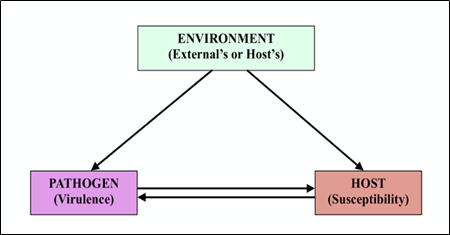
Fig. 1. Relationship between Pathogens-Hosts- Environment
Fortunately, we can act on all three factors involved in the transmission of infections, so they are called "modifiable factors".
The environmental factor is the easiest to control: it is the first intervention adopted worldwide against the pandemic by CoVID19 with the adoption of hygienic measures, hand washing, protective barriers (masks), and interpersonal isolation (quarantine). The intervention is certainly effective but requires an important change in habits and significant people’s restriction in the movement and freedom, and cannot be prolonged indefinitely.
Another factor on which to intervene is the pathogen itself, and for this reason, many research laboratories are committed worldwide to find an effective means to defeat it. However, as mentioned above, because of the evolution and development of resistance by pathogens, the effectiveness of this intervention has always been partial and transitory.
The best strategy to adopt is to act simultaneously on all pathogenetic factors, but with a particular focus on the target of infection: the host. The host is the final link in the infectious chain, and the ultimate recipient pathogen’s propagation and its healing can stop their survival and spread.
Why Boost Immune System
In combination with the prevention measures described above, an effective method for the host’s protection, consisting of strengthening the host’s immune Innate and Acquired defenses.
The immune system: has different levels of response:
Physical barriers of the Host:
Consisting of superficial epithelial coatings, mucus, and other secretions containing anti-microbial molecules, internal anatomical barriers (pleura, peritoneum, bands, etc.).
Innate immune response:
produced by "sentinel" cells residing in tissues (mast cells, macrophages, dendritic cells) "emergency response" cells coming from circulating blood (neutrophils, monocytes, and derivatives, eosinophils, NK-Natural Killer cells); soluble mediators (Ab: Antigen binding, natural, complement, acute phase proteins).
Acquired immune response:
Produced by lymphocyte cells B and T. They act with a specific (that is stored) antibody and cellular response to the pathogen.
Therefore, the effective strengthening of the immune system allows us to overcome and combat the aggressions of pathogens. This strategy is particularly useful for those who are more susceptible to infectious diseases, such as the elderly, children, and immunodeficient.
Nowadays we have many methods to improve the immune system, both with the use of drugs, or traditional medicine using the extractive or natural substances that the tradition and experience of the people have handed down to us. In particular, we know the effectiveness of many plant extracts, and some macros and microelements, which are used to prevent infections and support our immune system. The list is indeed extensive, and we cannot examine it in this context.
An interesting contribution to the identification of specific substances with immunomodulating activity is presented in the work of S.Maggini, from which we report the following explanatory Table 1 [11].
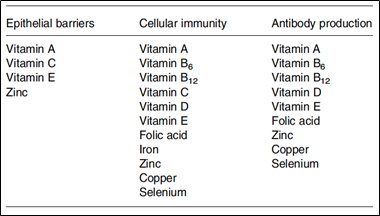
Table 1. Synthesis of micronutrient action sites and effects on the immune system
The table shows that the intake of specific vitamins: vitamin A, B6, B12, C, D, E, and Folic acid and the trace elements iron, zinc, copper, and selenium which work in synergy is useful to support the protective activities of the immune cells. [11].
But for these substances to be effective it is essential to know specific nutrient deficiencies that every person needs because improper and indiscriminate use of diet and unnecessary food supplements can be more harmful than useful.
The Hippocrates’s aphorism: "makes food your medicine", well expresses this concept.
Nutrigenomics, Epigenetics, and interaction between food and gene expression, Immunity
Thanks to the use of Nutrigenomics we are now able to discover, with the execution of genetic targeted tests, what are the nutritional and dietary deficiencies that every individual must fill.
Nutrigenomics studies the interactions between food and DNA, which occur through induction by Nutrients with epigenetic changes of DNA, that are stable, reversible changes of DNA, which cause regulation in gene expression, without modifying the original sequence. [12, 13].
Epigenetic told us that Nutraceuticals have the function of modulators that influence the development and maintenance of the organism.
The most important interactions between food and DNA are:
Food substances can influence the epigenetic mechanisms described above, between these DNA and histone methylation and histone acetylation, are the most important and used mechanisms. These interactions can occur through the direct action of food molecules on enzymes that catalyze epigenetic mechanisms or indirectly through alteration of the substrate availability of such enzymes [14-17].
Food molecules that play a key role include folic acid (vitamin B9), cobalamin (vitamin B12), pyridoxine (vitamin B6), riboflavin (vitamin B2), choline (vitamin J), methionine (an amino acid), betaine, serine and zinc that become part of the cycle or as enzymatic cofactors, molecular precursors or methyl group donors. A huge amount of work demonstrates the close link between these microelements and the strengthening of the immune system, we mention only a small part in references [11, 18-32]
Microbiome and immune system
In recent years an increasing interest has been focusing on the important role played by the Microbiome (the complex of microorganisms that colonizes our intestines), on the state of general well-being and the functioning of our immune system .Numerous clinical and experimental studies have highlighted the benefits obtainable with the use of Probiotics, selected bacterial strains also known as lactic ferments, which are administered orally, to colonize and modulate the intestinal flora. [33-39]
Many works and guidelines recommend taking multivitamins, plant extracts, and a good balance of intestinal flora for the efficient functioning of the immune system. Unfortunately, most of the nutrients supplements on the market have the disadvantage of being poorly absorbed and even less assimilated to fully express all their beneficial effects.
In particular, many vitamins and plant extracts have insufficient bioavailability and must be administered following precise indications. [40]
For Probiotics, the main drawback is their poor ability to take root and colonize the intestine. Thanks to pharmaceutical technology, the potential and therapeutic efficacy of these products can be greatly improved.
Among the various pharmaceutical technologies used nowadays, the most promising ones that have shown remarkable versatility are represented by:
Microencapsulation, and liposomal technology
Microencapsulation consists of the coating, covering, the nutrients to be administered, with polymers of various nature both extractive and synthetic. This technology allows you to: Improve stability, solubility, Mask the smell and taste of unpleasant substances. (Fig. 2)
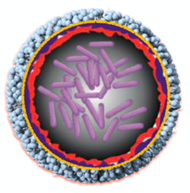
Fig. 2: Example of Microencapsulated Probiotics - Monocoated Microcapsule
The Liposomes are spherical vesicles formed by a double membrane of phospholipidic nature that contains within them the substances to be conveyed. With their hydrophobic, hydrophilic characters and smaller size, they actively deliver the drugs to site of action [41]. By structure and chemical composition, they are very similar to cell membranes with which they have high affinity and ease of absorption and assimilation Fig. 3 [42]
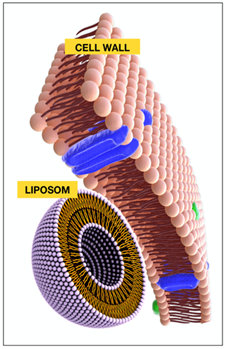
Fig. 3. Schematic comparison between Liposome and cell wall
Liposomal technology is widely used in the pharmaceutical field to improve the bioavailability of many drugs, which has a reduced therapeutic index, such as anticancer, antibiotics, vaccines, etc. [3] In this field, the Argentine company Lipotech (www.lipotech.com.ar) has obtained the most innovative results and has produced multifunctional liposomes, capable of transporting several substances simultaneously within the same liposomes, therefore they are registered under the trademark Probiosomial.
The advantages obtainable with this technology are manifold: with a single administration, the Probiosomas furnish at the same time the substances that have demonstrated greater immunostimulating efficacy, assuring their complete assimilation, even for active substances that are poorly absorbed.
For over 25 years, Lipotech has been producing liposome nutrients that are used by many multinational food companies, and have shown excellent efficacy and tolerability. [43-50]
In 2016 Lipotech also produced and patented the LIFERVIT, patent N 0001423818, which can provide, with liposomes, five substances particularly useful for the immune system.
A survey conducted at the University of Urbino demonstrated the liposomal nature of LIFERVIT and the ability to penetrate cell cultures [51]. (Fig. 4 - Fig. 5)
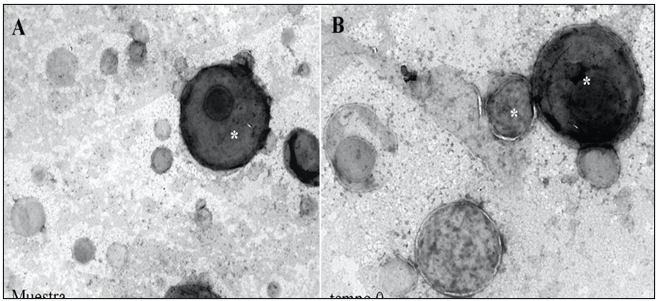
Fig. 4: Observation sample LIFERVIT with T.E.M. Transmission Electron Microscope
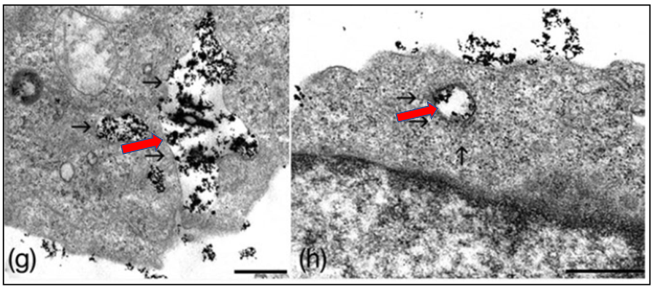
Fig. 5: Up-Take of the liposome (arrows) in myelocytic cell line U937 TEM micrograph
The substances present in Lifervit are Iron sulfate, Vitamin C, Folic Acid, Vitamin B6, and Vitamin B12.
The examination of Table 1. and a wide literature show that these 5 substances, together with other very studied substances, are essential for the proper functioning of the immune system. [11, 18-32] As mentioned above, the only drawback is the poor absorption and reduced bioavailability of these nutrients, in particular iron and vitamin B12, if administered as natively. [40, 52]
The liposomal/Probiosomial technology has solved this inconvenience, providing an effective instrument of primary prevention of infectious diseases, with the strengthening of the immune system. Different solutions can be obtained by adapting the content of "immunostimulating" substances to be inserted in liposomes, based on the specific nutrient deficiencies that people need, thus implementing the personalized immunotherapy.
The dual effectiveness of probiosomial technology and the role of the Microbiome
The Lifervit can exert double effectiveness in the prevention of infectious diseases: the immunostimulating effect, and the protection of the endothelium.
In fact, in addition to expressing safe effectiveness on the immune system, the association between folic acid, vitamin B6 and vitamin B12 present in Lifervit, has been shown to improve Homocysteine metabolism, which is a recognized independent cardiovascular risk factor, and is highly damaging to the endothelium, leading to thrombosis.
An important mechanism through which homocysteine promotes thrombosis is that linked to the proliferation of smooth muscle cells of blood vessels, and increased endothelial adhesion, deposition of low-density lipoproteins (LDL) and formation of foamy cells. Homocysteine also acts directly on platelet activation and endovascular aggregation, promoting thrombin formation and endothelial V-factor activation, inhibition of protein C, and reduction of antithrombin III activity. [53-56].
Further evidence on the pathogenic role of homocysteine comes from molecular investigations that have clarified its effect on fundamental proteins such as albumin, fibronectin, transthyretin, and metallothionein. The molecular mechanism involved concerns the binding of homocysteine on these proteins and is defined S-homocysteinylation, thus S-homocysteinylation of protein cysteine residues may explain mechanistically the cytotoxicity of elevated L-homocysteine. [56]
Finally, complete work on the effects of hyperhomocysteinemia contains a detailed bibliographical reference on the pathogenic mechanism of arterial occlusion [57], in the following very explanatory Table 2:
Table 2: Hyperhomocysteinemia and Arterial Occlusive Disease; Citation of some studies that demonstrate correlation
* HC indicates homocysteine; CAD, coronary artery disease; CVD, cerebrovascular disease; PVD, peripheral vascular disease; HHC, hyperhomocysteinemia; MI, myocardial infarction; and MTHFR, methylenetetrahydrofolate reductase.
From the above CoVID19 and Homocysteine, although following two different routes they have a common pathogenetic fate: endothelial dysfunction and thrombosis.
Lifervit allows simultaneous action on both pathogenic pathways:
• prevention of contagion, CoVID19, promoting the immune system ;
• prevention of thrombosis in patients CoVID19, improving homocysteine metabolism.
“Our blood vessels are the lifelines for all of our organs. If CoVID-19 damages our vessels, the long-term effects could be devastating even after the virus is cleared. Finding ways to protect our blood vessels and helping them heal could be an important dimension to CoVID-19 treatment. These interventions could involve not only medications but importantly, dietary factors and lifestyle.” [3]
Another effective tool in the prevention of infectious diseases is provided by the modulation of the Microbiome. With the administration of selected microencapsulated bacterial strains, we can positively boost our immune system.
Numerous experimental and clinical controlled studies have demonstrated the usefulness of this approach. [33-39].
Conclusions
Alongside the traditional therapies most used to combat infectious diseases, we now have effective meaning available that can complement or become of primary importance in cases of failure of the protocols used routinely.
With this work, we want to highlight that other promising and safe approaches are possible to combat present and future infectious diseases and to promote well-being and public health, concurrently, or with other available therapies.
Only the clinical experience conducted on a wide range of controlled cases can give us more security in the most effective therapeutic choices in the treatment of infections. In any case, the awareness is growing that there is no single and effective treatment in all situations, and for all patients, precisely as the CoVID19 shows us.
In this regard, if we want to adopt this approach, it is good to remember the importance of a preventive analysis of immune deficits and specific nutrient deficiencies that every person needs, to choose the most effective therapies.
Hematological and genetic tests provide essential support for this purpose and avoid improper and unjustified use of diet, food supplements, or drug therapies of no proven efficacy, which in addition to being expensive can compromise the health of users.
Only in this way can each patient have "his" specific therapy.
The mission of Lipotech is to provide the Probiosomial technology for the production of customized immunomodulating supplements effective, or other specific needs for primary prevention and general well-being.
Disclosure
The authors report no conflicts of interest in this work.
References
